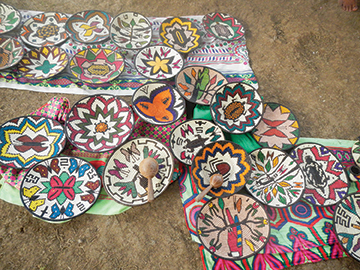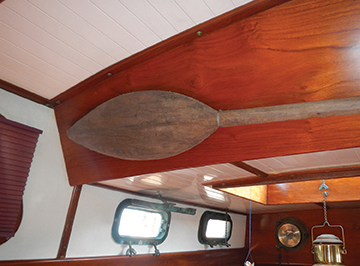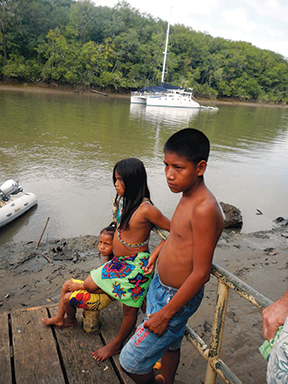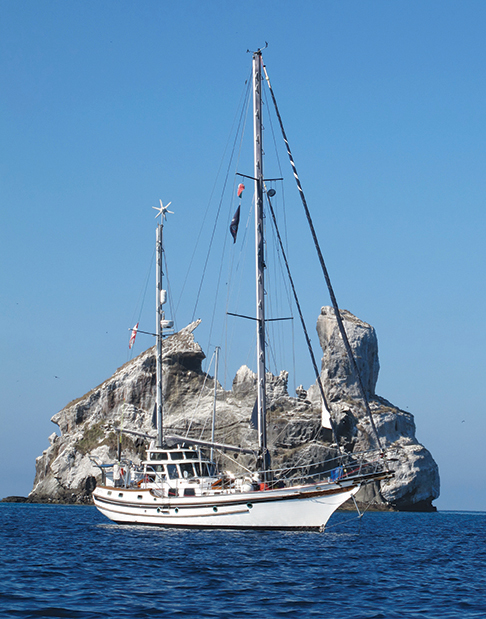A buddy cruise into the wilds of Panama makes for an enriching experience (published May 2014)
As any cruiser knows, getting off the beaten track is both liberating, and potentially fraught with real and imaginary disasters. The two of us aboard Sundancer are always looking to add notches of “the different” to our sailing resume, but sometimes a suggestion to voyage to an exotic locale with other cruisers is a welcome change. With five other boats, a plan was hatched to head into the most remote and least visited part of Panama, the Darien, located within Gulfo de San Miguel.

GETTING THERE
Located approximately 80 miles southeast of Panama City, the Gulf can be accessed directly from the city, although traveling this way has you bucking a north setting current along the eastern coast of the bay. Another way, and the one we chose, was to head there as an add-on to our holiday celebrations in the Las Perlas Islands. We had all rendezvoused at Isla Espiritu Santo; a beautiful anchorage located a quarter of the way south along the eastern side of the largest island, Isla del Rey. Christmas having come and gone, we thought that perhaps New Year’s Eve 2013 would be unique, spending it up the Rio Sambu, accessible from the southernmost portion of the Gulf.
During the months of December to April, typical north winds had us reaching for the asymmetrical to calmly access the entrance to the Gulf southeast of Espiritu Santo. The 30 miles was covered quickly and we all dropped anchor for the night, just inside Punta Garachine, protected somewhat from the southern swell coming into the Bay. When the winter north winds blow strongly, be aware that this anchorage could make for an interesting night.
We all agreed that the next day, mid-morning on the rising tide, would see adequate water depths covering the mud flats that surrounded the mouth of the river. For those unfamiliar with the radical tidal changes on the Pacific side of Panama, a look at the tidal calendar will prevent any groundings, as swings of up to 20 feet are not uncommon.
UP THE RIVER WE GO
We were a bit anxious to get up the river and started out sooner than we perhaps should have, and as such, a few of us kissed the muddy bottom. But within minutes we were through the channel and into the Rio proper.

Our destination was La Chunga, an Embera pueblo located seven miles from the mouth of the river. The Darien is home to several indigenous tribes, with the Embera and Wounaan being two of the more familiar ones. Known in the souvenir shops in Panama City and throughout the country for their cocobolo and tagua nut carvings, and beautiful basketry, these tribes are still on the cusp of tourism and don’t receive many visitors. We had visited several Wounaan villages last year in the northern rivers of the Gulf and discovered that we were the only boat they had seen that year. So we were looking forward to seeing how those Wounaan differed to this Embera village. One of the boats we were with had visited La Chunga several times over the last few months and became our unofficial tour guide for this trip.
We spent a few peaceful hours drifting upriver on the incoming tide spotting parrots, herons, and egrets, and hearing the odd monkey, and before long we were there.
Dropping the anchor opposite the portside floating dock was simple, and we made sure to set it well as the incoming and outgoing tides clipped along at a good 4 to 6 knots, which would test the holding of our ground tackle. As our lead boat had become familiar friends with the village elders, the children and the designated Spanish-speaking representative surrounded us within minutes. We all conferred and agreed that the full complement of village activities would be provided the next day for a very reasonable price of $25 per boat.
A WARM WELCOME
The next day at the agreed upon time, we all rendezvoused at the dock. As it was low tide, the trip from dinghy to dock was a bit muddy, which no one seemed to mind. Due to the tide, we were unable to take our dinghies upriver to the bridge, marking the beginning of the village, but there was a fine boardwalk built through the mangroves that led us onwards to the first of our greetings to the village.

A short walk further along the river’s edge and we came to the village proper, where they put on a few dances signifying the animals in their world, a demonstration of how they extract juice from the sugar cane—some of us jumped in to give it a turn or two—and a little marketplace where the women of the village showed off their wares; minus the inflated rates you would find in the city.
Without exception, the people of La Chunga were welcoming, gladly inviting us into their homes and their community. They showed us their local freshwater swimming hole, where we competed with the children as to who could show off the most. Not wanting to take what little food these people might have, we gladly purchased eggs and received gifts of banana bunches, coconuts and lengths of sugar cane.

While admiring the basketry, Ron and I decided a fitting remembrance to our visit to La Chunga would be a paddle. While not new, we traded an unopened box of fishhooks and line for the newest addition to our Panamanian memories, now proudly hanging in our salon.

The term “going native” always means different things to different people. In our own way, we too wanted to take a piece of this most special of Embera villages away with us. The tribal custom of “hagwa” is a temporary tattoo, applied from the juice and pulp of a local fruit. Used for ceremonial purposes, it lasts upwards of seven days. They were amazed when Ron told them that his “hagwa” lasted a lifetime.

As sailing explorers, sometimes a bit of effort is needed to leave the pristine beaches and clear waters of many of our worlds’ special ocean hideaways. We have always felt that the energy and planning needed is always worth the effort. It would be easy to just stay at anchor, never testing our navigational or sailing skills, but we aim to pack our memory boxes full, and while sometimes those “not so pleasant” remembrances cause us to shudder, more often than not we are rewarded with a life enriched.

After 30 years in the snow skiing industry, Heather stepped out of her skis and onto a 47-foot Vagabond ketch. Along with her own “Captain Ron”, they started traveling down the Pacific coast from British Columbia, Canada, looking for high seas and low latitudes. They found both, and are happy to report that there are no plans to quit cruising anytime soon.















